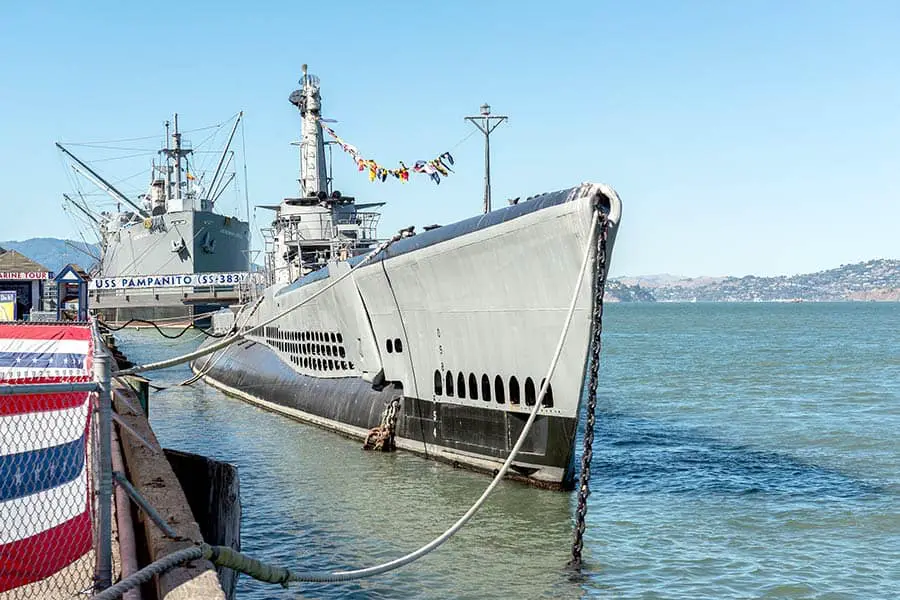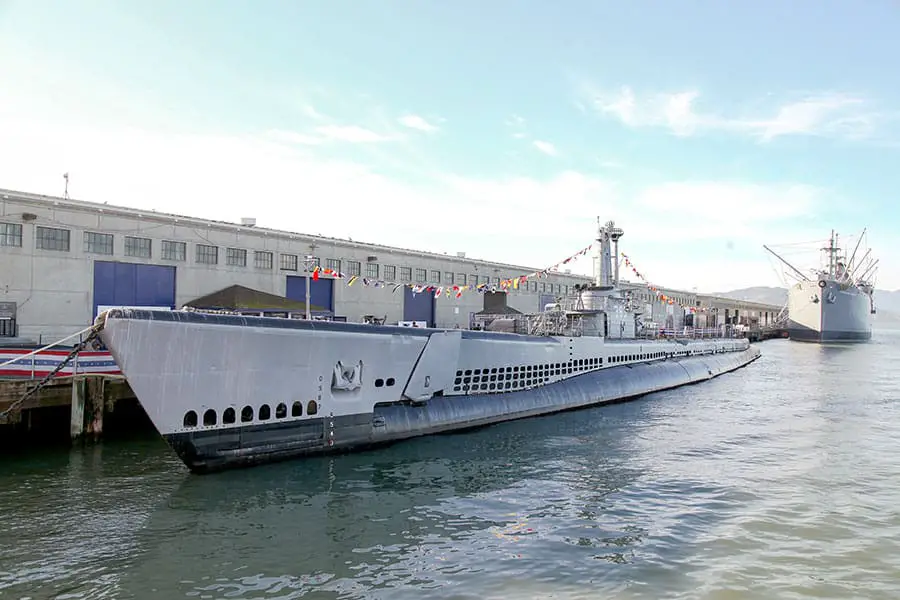
Exploring the Fisherman’s Wharf complex for the first time can be a bit overwhelming. As an overabundance of family activities, restaurants, cafés, and stores jockey for your attention, it’s almost impossible to see, yet let alone do, everything the area has to offer. But there is one hard-to-miss attraction you have likely noticed, even on the busiest of days—a ship docked in the bay. For many, this sight leads them to wonder: “Just what is the name of that submarine? And why is it there?”
The name of the ship resting along Fisherman’s Wharf complex in San Francisco, California is the USS Pampanito; a submarine turned National Historic Landmark with a fascinating history dating back to World War II. Retired from war, the USS Pampanito Museum now hosts nearly 250,000 visitors annually.
From heroic war efforts to a Hollywood appearance, there’s plenty to learn about the iconic submarine docked at Pier 45. To take a deep dive into the valiant warship turned museum, read on.
San Francisco – Home of the USS Pampanito
The ship nestled along Fisherman’s Wharf-Pier 45 at the end of Taylor and Embarcadero Streets in San Francisco, California, is the USS Pampanito. Getting its name from the Pampanito fish for their slender, brown, black, silver, and yellow appearance, the Pampanito is now a museum.
As a part of the San Francisco Maritime National Historical Park, it is open daily from 10 am to 6 pm and can be viewed from the pier. Or, for those who are more interested in the vessel’s history, there are self-guided audio tours available when walking through the ship.
For those not in the San Francisco Area, the Maritime National Park Association offers a plethora of online audio and visual tours, most of which come from the original crews that had been aboard the ship during World War II.

A Brief History of San Francisco’s USS Pampanito
With World War II finished and the USS Pampanito still intact, the warship would be decommissioned on December 15, 1945. For the time being, her new home was Mare Island, a peninsula in the city of Vallejo, California. It wasn’t until the 60s that the USS Pampanito would see use again. Action for the war vessel came this time in the form of a training platform for Naval Reserve Submarine Division 11-12.
However, this training stint wouldn’t last long, as the USS Pampanito was selected for the fleet stripping program in 1970. Induction into this program meant many parts of the USS Pampanito would be removed to supply other submarines with spare parts. With this came the USS Pampanito’s removal from Navy record and eventual transfer to the Maritime Park Association in 1976.
The initial attempt to berth the USS Pampanito at Fisherman’s Wharf was blocked by the San Francisco Port Commission and resulted in the ship moving from Mare Island to a private shipyard in Stockton.
The USS Pampanito’s fate remained in limbo for six years until the San Francisco Port Commission’s change of heart allowed the USS Pampanito to dock at Fisherman’s Wharf. Here the USS Pampanito would be opened to the public in 1982 and go on to become one of the most visited historic vessels in the country—but this wasn’t Pampanito’s only claim to fame.
In spite of the fleet stripping program in 1970, much of the USS Pampanito has been restored to its original form. Parts have been scavenged from all across the nation to make this possible, and these restorative efforts continue to take place even decades after Pampanito’s original creation.
To aid in sending the Pampanito back to the past, the Pampanito is scheduled to dry dock every seven years. The dry docking process is a costly operation where various repairs and maintenance tasks are completed to preserve the USS Pampanito’s wartime form.
Pampanito is actually the only historic naval vessel having completed four dry dockings as a museum. There are extensive records kept of all the work that has been done in order to preserve and maintain the quality of the Naval relic. The book where these records are kept is currently over 300 pages long and details the work done on some of the following:
- Equipment Replacement
- Operational System Maintenance
- Hydraulic System Maintenance
- Electrical Maintenance
The above list doesn’t even cover half of the work that goes into making the USS Pampanito something that future generations can enjoy. Over the years, countless staff members, volunteers, and donors have all played a role in making the Pampanito the landmark it is today.
The persistent large-scale effort to conserve such an integral piece of American and nautical history is what makes the Pampanito truly special.

Where Was the USS Pampanito Built
The USS Pampatino’s construction began on March 15, 1943, at the Portsmouth Naval Shipyard located on Seavey Island across the harbor from Portsmouth, New Hampshire. During World War II, the Portsmouth Naval Shipyard was the leader in the design and development of submarines and oversaw most of the significant repairs.
The shipyard built over 75 submarines for the war effort and made record-breaking history by launching four submarines in one day. The Naval Shipyard is and has been responsible for producing many wartime submarines and ships, dating back to as early as 1814.
The USS Pampanito was launched on July 12, 1943, and was later officially commissioned as part of the U.S. Naval Fleet on November 6, 1943.
Bay Area Answers Fun Fact: The USS Pampanito carried ten officers and 70 crew members, who shared 60 bunks, three toilets, two showers, and two sinks. Officers had their own bunks. It’s believed the chefs aboard the Pampanito served the best meals in the U.S. Navy.
Other Posts of Interest
- What Was Treasure Island Used For?
- Is Ghirardelli Chocolate Made in San Francisco?
- What Is Alcatraz Used For Now?
- How Do You Get Around On Angel Island?
What Class is the USS Pampanito
The Pampanito is a Balao-class submarine, and it was brought into service during the Second World War in the middle of 1943. The Balao-class played an essential part in the war by contributing to the fighting in the underwater arena.
In fact, this submarine class was instrumental to the devastation of the Imperial Japanese Navy. Furthermore, the Japanese merchant ships were also targeted heavily by the Balao-class submarines and inflicted significant damage to them also.
More than 119 of these stealthy vessels were completed between the years 1942 to 1945. Through the use of stronger steel, Balao-class submarines were capable of diving 400 feet instead of the mere 300 feet of its predecessor, the Gato class. Balao-class submarines were so successful during World War II that the Balao-class became the largest class of submarines in the United States Navy.
How Many Battle Stars Does the USS Pampanito Have
These wartime efforts earned the USS Pampanito six battle stars, each star representing meritorious participation in battle. These service stars symbolize the valiant efforts of the Pampanito and its crew during World War II.
Although Pampanito’s wartime is over, the six battle stars will forever be a part of the USS Pampanito’s history and will epitomize the efforts of all who fought and made sailing on the ship possible.
During World War II, the USS Pampanito sank six enemy ships, damaged 4, and rescued 73 Australian and British prisoners of war, who were onboard sunken enemy ships that had been transporting them to Japan, as part of its six war patrols during World War II.
Is the USS Pampanito Seaworthy?
There are fewer and fewer surviving items from the World War II era each year. As pieces of history continue to fall victim to time, it can be hard to imagine any wartime relics still being functional decades later. Of these surviving items, one might think it impossible for something as large as a ship to be still capable of setting sail in the modern day.
So, with all that effort that goes into freezing the USS Pampanito in time, “Is it seaworthy today?” you might wonder. And to answer that, yes. In fact, the USS Pampanito is a part of a very select group of ships that are still seaworthy from World War II. As such, the USS Pampanito has been designated a National Historic Landmark for its significant impact on American history.

What Submarine Did They Use for the Movie Down Periscope?
Pampanito would eventually land the role of the old, decrepit USS Stingray in the 1996 military comedy Down Periscope directed by David S. Ward. The film follows the rivalry between Commander Tom Dodge and Admiral Yancy Graham as they and their crews partake in a simulated challenge at sea that will decide Dodge’s future in the Navy.
Pampanito starred alongside numerous big-name celebrities such as Kelsey Grammer, Lauren Holley, Rob Schneider, Rip Torn, and Bruce Dern but didn’t do so in the capacity you may think.
Though there were plenty of surface shots of the USS Pampanito, she was never moving using her own power. Instead, the Pampanito was being towed and made to look as if she was operating normally. And the underwater shots? Those were simply scale models used in place of the Pampanito.
With the USS Pampanito’s days of being on the big screen in its past, the submarine remains open as a museum. Efforts to preserve and maintain the ship’s wartime appearance is carried out seven days a week and are a part of an ongoing commitment made by the San Francisco Maritime National Park Association.
Why Should I Visit the USS Pampanito
While there are many reasons to visit the USS Pampanito, it is important to remember: although current preservation efforts have been successful, this may not always be the case. As it is, there are very few standing memories of World War II, but fortunately for us, Pampanito sits proudly as one of those memories.
The exhaustive history of the Pampanito not only captures the stories of a distant past, but the USS Pampanito also serves as a symbol of honor to those who served, and continue to serve, the United States of America. The impact of the USS Pampanito can only truly be understood through the experience.
With family passes for two adults and two children costing less than $50, the USS Pampanito is a relatively inexpensive tourist destination when in the Bay Area for those seeking to learn more about naval history. And to also experience what it may have been like to be aboard a submarine during World War II.
Don’t Miss the Chance to Be a Part of History
There’s plenty of reasons that over 250,000 people visit the USS Pampanito each year. As a long-standing symbol of American technological advancement, war history, and memory to those who served during World War II, Pampanito is a must-see when in the Fisherman’s Wharf area.
Your support also assists in the ongoing efforts to preserve the USS Pampanito for future generations to enjoy and learn from. Remember, what’s here today isn’t always here to tomorrow. So don’t miss your chance to be a part of history.





